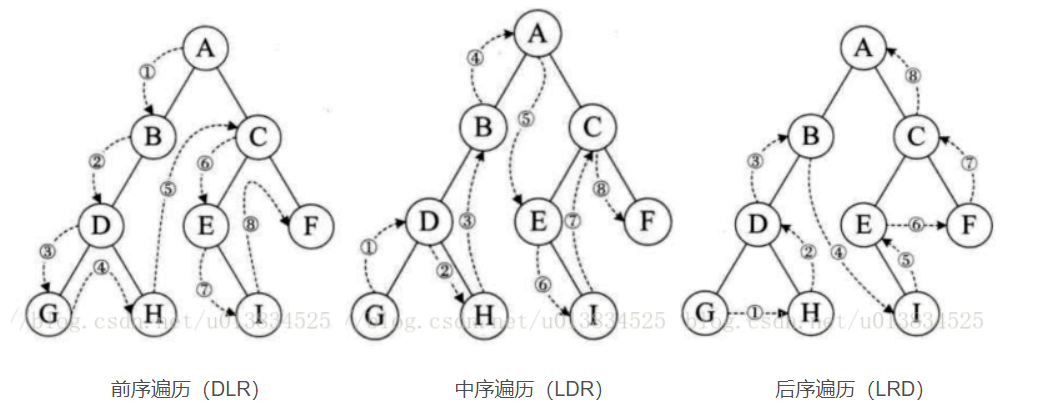您现在的位置是:首页 >其他 >二叉树基础知识&力扣题构造二叉树总结网站首页其他
二叉树基础知识&力扣题构造二叉树总结
二叉树
如何理解二叉树,This is a question!
作者在去年被布置要求学习二叉树时对二叉树的理解并不是很深刻,甚至可以说是绕道走,但是Luck of the draw only draws the unlucky,在学期初考核时,作者三道二叉树题都没做出来,连最简单的创建都忘记了,当时想着提升,却拖到了现在;
这篇文章可以说是作者二叉树算法实战经验总结
基础知识
先来回顾一下二叉树的基本知识;但还是请读者曾经是见过二叉树的
一颗很普通的二叉树,他的定义是:是n(n>=0)个结点的有限集合,该集合或者为空集(称为空二叉树),或者由一个根结点和两棵互不相交的、分别称为根结点的左子树和右子树组成;
其余的基本知识,还是请自行搜索一下;现在来了解几种遍历手法

int len;
//DLR
void DFS(int*arr,struct TreeNode*root) {
if(root == NULL) return;
arr[len] = root->val;
len++;
DFS(arr,root->left);
DFS(arr,root->right);
}
int* preorderTraversal(struct TreeNode* root, int* returnSize){
int*arr = (int*)malloc(sizeof(int)*100);
len = 0;
if(root != NULL)
DFS(arr,root);
*returnSize = len;
return arr;
}
int len;
//LRD
void DFS(int*arr,struct TreeNode*root) {
if(root == NULL) return;
DFS(arr,root->left);
DFS(arr,root->right);
arr[len] = root->val;
len++;
}
int* postorderTraversal(struct TreeNode* root, int* returnSize){
int*arr = (int*)malloc(sizeof(int)*100);
len = 0;
if(root != NULL)
DFS(arr,root);
*returnSize = len;
return arr;
}
int len;
//LDR
void DFS(int*arr,struct TreeNode* root) {
if(root == NULL) return;
DFS(arr,root->left);
arr[len] = root->val;
len++;
DFS(arr,root->right);
}
int* inorderTraversal(struct TreeNode* root, int* returnSize){
len = 0;
int*arr = (int*)malloc(sizeof(int)*100);
if(root != NULL) {
DFS(arr,root);
}
*returnSize = len;
return arr;
}
在三种遍历方法中,我们都采用了递归的方法,而仔细观察也会发现,这三段代码的区别,从字面上仅是递归函数的位置不同,也就是遍历时的顺序不同,这个也就是我们在解决二叉树算法题时要注意的点,不同的遍历方式对应着不同的类型的解决方案
在这三种遍历代码前,都标注了三个大写字母,D、L、R 分别代表遍历根结点、遍历左子树、遍历右子树,会发现字母的顺序也就代表着优先级也就是代码呈现的顺序;
如何理解这种遍历手法,以前序遍历为例,他的三个字母顺序为DLR,也就是根节点最优先,自然就是A,之后就到B,C这两个在这里判断的条件就成了谁左谁优先,也就是B先行,B的底下还有子树,坚持D最优先原则,由于他们有一个优秀的父结点,因为所有都可以得到先行一步的遍历权利,等到遍历完了也就是在轮到C和C的子树;
总结就是:坚持大方向,父结点优先,子结点也继承了优先权
那么基础知识就讲到这里,接下来实战演练
实战演练
这是一道非常基础的题目,也就是再问一根树枝最长能有多长,也就是遍历出奇迹
第一种方法:回溯
(探索与回溯法)是一种选优搜索法,又称为试探法,按选优条件向前搜索,以达到目标。但当探索到某一步时,发现原先选择并不优或达不到目标,就退回一步重新选择,这种走不通就退回再走的技术为回溯法,而满足回溯条件的某个状态的点称为“回溯点”
对这种算法的解释就是:一条道走到黑,且要走完每条道
先看代码:
class Solution {
int depth = 0;
int res = 0;
public int maxDepth(TreeNode root) {
traverse(root);
return res;
}
void traverse(TreeNode root) {
if (root == null) {
return;
}
depth++;
// 遍历的过程中记录最大深度
res = Math.max(res, depth);
traverse(root.left);
traverse(root.right);
depth--;
}
}
对代码的唯一不理解的地方应该是为何要先depth++之后又depth--,我们可以把整个函数理解为一个在四处游走的图钉,当图钉到这个点上了,depth++,现在我小图钉在这里一条道走到黑要离开去其他地方了,那么则先depth--,因为回到更上面一层去了;这跟前序遍历很像
至于res的取值,只要放在depth--之前就行了
第二种方法:动态规划
class Solution2 {
// 定义:输入一个节点,返回以该节点为根的二叉树的最大深度
public int maxDepth(TreeNode root) {
if (root == null) {
return 0;
}
int leftMax = maxDepth(root.left);
int rightMax = maxDepth(root.right);
// 根据左右子树的最大深度推出原二叉树的最大深度
return 1 + Math.max(leftMax, rightMax); //+1的原因:算上根节点
}
}
代码很好理解,但是作者自己想不出来;思想很简单,也是遍历然后最后得出最大值,这个顺序相当于在后序遍历
其实这道题跟上面一道题非常像,作者对这道题的解读就是:从根节点出发第一长的树枝和第二长的树枝长度和;那么这道题也就迎刃而解了,只要在上一题的第二种解法种稍加修改,添加一个max记录值,便可以做出该题
/**
* Definition for a binary tree node.
* public class TreeNode {
* int val;
* TreeNode left;
* TreeNode right;
* TreeNode() {}
* TreeNode(int val) { this.val = val; }
* TreeNode(int val, TreeNode left, TreeNode right) {
* this.val = val;
* this.left = left;
* this.right = right;
* }
* }
*/
class Solution {
int maxDiameter = 0;
public int diameterOfBinaryTree(TreeNode root) {
maxDepth(root);
return maxDiameter;
}
int maxDepth(TreeNode root) {
if(root == null) {
return 0;
}
int leftMax = maxDepth(root.left);
int rightMax = maxDepth(root.right);
int myDiameter = leftMax + rightMax;
maxDiameter = Math.max(myDiameter, maxDiameter);
return 1 + (Math.max(leftMax, rightMax));
}
}
这道题的神奇之处就在于,把不是一个父结点,但是在同一层的联系在了一起,那么只要把相对位置是left&right的都链接在一起,也就是多加一条执行语句traverse(node1.right, node2.left)即可
class Solution {
public Node connect(Node root) {
if(root == null) {
return null;
}
traverse(root.left, root.right);
return root;
}
void traverse(Node node1, Node node2) {
if(node1 == null || node2 == null) {
return;
}
node1.next = node2;
traverse(node1.left, node1.right);
traverse(node2.left, node2.right);
traverse(node1.right, node2.left);
}
}
它使用HashMap来存储中序遍历数组中值到索引的映射关系,这有助于确定根节点并将数组划分为子树以进行递归构建。
buildTree 方法接受前序遍历和中序遍历数组作为输入,并通过将中序遍历数组中的值和索引存储在 valToIndex HashMap 中来进行初始化。然后,它调用 build 方法,传递必要的参数来构建二叉树。
build 方法是一个递归函数,用于构建二叉树。它检查子树是否为空(preStart > preEnd),如果是则返回null。否则,它从前序遍历数组中确定根节点的值(preorder[preStart]),并找到它在中序遍历数组中的索引。然后,它计算左子树的大小(index - inStart),并先构造当前根节点。接下来,它递归构建左子树和右子树,并将它们连接到根节点。最后,它返回根节点
class Solution {
// 存储 inorder 中值到索引的映射
HashMap<Integer, Integer> valToIndex = new HashMap<>();
public TreeNode buildTree(int[] preorder, int[] inorder) {
for (int i = 0; i < inorder.length; i++) {
valToIndex.put(inorder[i], i);
}
return build(preorder, 0, preorder.length - 1, inorder, 0, inorder.length - 1);
}
/*
定义:前序遍历数组为 preorder[preStart..preEnd],
中序遍历数组为 inorder[inStart..inEnd],
构造这个二叉树并返回该二叉树的根节点
*/
TreeNode build(int[] preorder, int preStart, int preEnd, int[] inorder, int inStart, int inEnd) {
if (preStart > preEnd) {
return null;
}
// root 节点对应的值就是前序遍历数组的第一个元素
int rootVal = preorder[preStart];
// rootVal 在中序遍历数组中的索引
int index = valToIndex.get(rootVal);
int leftSize = index - inStart;
// 先构造出当前根节点
TreeNode root = new TreeNode(rootVal);
// 递归构造左右子树
root.left = build(preorder, preStart + 1, preStart + leftSize, inorder, inStart, index - 1);
root.right = build(preorder, preStart + leftSize + 1, preEnd, inorder, index + 1, inEnd);
return root;
}
}
class Solution {
// 存储 inorder 中值到索引的映射
HashMap<Integer, Integer> valToIndex = new HashMap<>();
public TreeNode buildTree(int[] inorder, int[] postorder) {
for (int i = 0; i < inorder.length; i++) {
valToIndex.put(inorder[i], i);
}
return build(inorder, 0, inorder.length - 1, postorder, 0, postorder.length - 1);
}
/*
定义:
中序遍历数组为 inorder[inStart..inEnd],
后序遍历数组为 postorder[postStart..postEnd],
构造这个二叉树并返回该二叉树的根节点
*/
TreeNode build(int[] inorder, int inStart, int inEnd, int[] postorder, int postStart, int postEnd) {
if (inStart > inEnd) {
return null;
}
// root 节点对应的值就是后序遍历数组的最后一个元素
int rootVal = postorder[postEnd];
// rootVal 在中序遍历数组中的索引
int index = valToIndex.get(rootVal);
// 左子树的节点个数
int leftSize = index - inStart;
TreeNode root = new TreeNode(rootVal);
// 递归构造左右子树
root.left = build(inorder, inStart, index - 1, postorder, postStart, postStart + leftSize - 1);
root.right = build(inorder, index + 1, inEnd, postorder, postStart + leftSize, postEnd - 1);
return root;
}
}
class Solution {
// 存储 postorder 中值到索引的映射
HashMap<Integer, Integer> valToIndex = new HashMap<>();
public TreeNode constructFromPrePost(int[] preorder, int[] postorder) {
for (int i = 0; i < postorder.length; i++) {
valToIndex.put(postorder[i], i);
}
return build(preorder, 0, preorder.length - 1, postorder, 0, postorder.length - 1);
}
// 定义:根据 preorder[preStart..preEnd] 和 postorder[postStart..postEnd]
// 构建二叉树,并返回根节点。
TreeNode build(int[] preorder, int preStart, int preEnd, int[] postorder, int postStart, int postEnd) {
if (preStart > preEnd) {
return null;
}
if (preStart == preEnd) {
return new TreeNode(preorder[preStart]);
}
// root 节点对应的值就是前序遍历数组的第一个元素
int rootVal = preorder[preStart];
// root.left 的值是前序遍历第二个元素
// 通过前序和后序遍历构造二叉树的关键在于通过左子树的根节点
// 确定 preorder 和 postorder 中左右子树的元素区间
int leftRootVal = preorder[preStart + 1];
// leftRootVal 在后序遍历数组中的索引
int index = valToIndex.get(leftRootVal);
// 左子树的元素个数
int leftSize = index - postStart + 1;
// 先构造出当前根节点
TreeNode root = new TreeNode(rootVal);
// 递归构造左右子树
// 根据左子树的根节点索引和元素个数推导左右子树的索引边界
root.left = build(preorder, preStart + 1, preStart + leftSize, postorder, postStart, index);
root.right = build(preorder, preStart + leftSize + 1, preEnd, postorder, index + 1, postEnd - 1);
return root;
}
}






 U8W/U8W-Mini使用与常见问题解决
U8W/U8W-Mini使用与常见问题解决 QT多线程的5种用法,通过使用线程解决UI主界面的耗时操作代码,防止界面卡死。...
QT多线程的5种用法,通过使用线程解决UI主界面的耗时操作代码,防止界面卡死。... stm32使用HAL库配置串口中断收发数据(保姆级教程)
stm32使用HAL库配置串口中断收发数据(保姆级教程) 分享几个国内免费的ChatGPT镜像网址(亲测有效)
分享几个国内免费的ChatGPT镜像网址(亲测有效) Allegro16.6差分等长设置及走线总结
Allegro16.6差分等长设置及走线总结